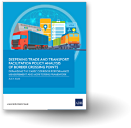Money and Finance
ASEAN+3 Finance Ministers Process Initiative
As it developed, the Association of Southeast Asian Nations (ASEAN) pursued cooperative ties with other East Asian countries, in particular the People’s Republic of China, Japan, and the Republic of Korea. The Joint Statement on East Asia Cooperation, issued in November 1999, serves as the main framework for the ASEAN+3 Finance Ministers Process. The Process aims to strengthen policy dialogue, coordination, and collaboration on common financial, monetary, and fiscal issues. The Process has four components: (i) the Economic Review and Policy Dialogue (ERPD); (ii) the Chiang Mai Initiative (CMI); (iii) the Asian Bond Markets Initiative (ABMI); and (iv) the ASEAN+3 Research Group.
ERPD aims to contribute in the prevention of financial crises through the swift implementation of remedial policy actions. It also focuses on issues of common interest. It likewise aims to prepare the foundation for providing immediate assistance, such as CMI, in the event of a crisis. Under the ERPD, ASEAN+3 Finance Ministers meet annually (their deputies meet semiannually) to discuss economic and policy issues.
CMI was initiated at the ASEAN+3 Finance Ministers’ Meeting in May 2000. It was created to provide a regional financing arrangement in order to supplement existing international facilities through a network of bilateral swap and repurchase agreements among ASEAN+3 members. The CMI also expanded the ASEAN Swap Arrangement (ASA), established in 1977, to include all ASEAN members.
The ASEAN+3 Finance Ministers endorsed ABMI during their August 2003 official meeting. A key initiative to increase financial cooperation in East Asia, the ABMI aims to develop efficient and liquid bond markets, which would enable better utilization of Asian savings for Asian investments. Likewise, it aims to contribute in mitigating financial currency and maturity mismatches. Six voluntary working groups were established to focus on areas crucial for bond market development. These include (i) new securitized debt instruments; (ii) credit guarantee mechanisms; (iii) foreign exchange transactions and settlement issues; (iv) issuance of bonds denominated in local currency by Multilateral Development Banks (MDBs), foreign government agencies, and Asian multinational corporations; (v) local and regional rating agencies; and (vi) technical assistance coordination.
The ASEAN+3 Finance Ministers set up a voluntary research group in August 2003 to explore ways of further strengthening regional financial cooperation and support the Process. The first ASEAN+3 Research Group meeting was held in March 2004. Recognizing the importance to further build intellectual capital across the region, in May 2005 the ASEAN+3 Finance Ministers endorsed three research areas for 2005 to 2006: (i) capital flow liberalization and institutional arrangements; (ii) capital market development, including the asset management industry; and (iii) policy coordination. The Asian Development Bank (ADB) has supported the initiatives undertaken under the ASEAN+3 Finance Ministers Process which include, among others, hosting the AsianBondsOnline website, a one-stop information clearinghouse on bond market development within the region; conducting studies for the ABMI working groups on credit guarantee mechanisms and regional clearing and settlement mechanisms; and supplying technical assistance in developing a regional early warning system (EWS) and in capacity building to strengthen the surveillance capacity of participating member countries.
ASEAN+3 includes the 10 members of the Association of Southeast Asian Nations (Brunei Darussalam, Cambodia, Indonesia, the Lao People’s Democratic Republic, Malaysia, Myanmar, the Philippines, Singapore, Thailand, and Viet Nam) plus the People’s Republic of China, Japan, and the Republic of Korea.
Agreements
- Joint Statement of the 25th ASEAN+3 Finance Ministers and Central Bank Governors MeetingAssociation of Southeast Asian Nations (ASEAN) Secretariat12 May 2022
- Joint Statement of the Third High-level Regional Financing Arrangment DialogueAMRO10 Oct 2018
- The Joint Statement of the 21th ASEAN+3 Finance Ministers' and Central Bank Governors' MeetingAMRO4 May 2018
- The Joint Statement of the 2nd High-Level Regional Financing Arrangement DialogueAMRO11 Oct 2017
- The Joint Statement of the 20th ASEAN+3 Finance Ministers' and Central Bank Governors' MeetingAMRO5 May 2017
News
- [People's Republic of] China, Singapore eye deeper cooperationAsia News Network27 Oct 2025
- Indonesia issues first yuan-denominated bonds worth $842 millionJakarta Globe25 Oct 2025
- Indonesians can use [Quick Response Code Indonesian Standard (QRIS)] in Japan and [People's Republic of] China starting August 17, 2025Antara21 May 2025
- ASEAN+3 to ramp up regional financial cooperation to cushion global trade shocksBusiness World6 May 2025
Opinions and Editorials
- Innovative financing key to private sector participation in ASEAN+3 Infrastructure Development – ADBKhmer Times3 May 2023
- Japan's megabanks are on the march in Southeast AsiaNikkei Asia (subscription)21 Jan 2016
- Why does [Republic of] Korea want currency deal with Japan?Nikkei Asia (subscription)20 Jan 2016
- Japan, [Republic of] Korea, [People's Republic of] China may put agreements back in placeNikkei Asia (subscription)14 Jan 2016
Studies and Research
- Is International Monetary Policy Coordination Feasible for the ASEAN-5 + 3 Countries?E. A. SugandiAsian Development Bank16 May 2020
- Facilitating Foreign Exchange Risk Management for Bond Investments in ASEAN+3Asian Development BankAsian Development Bank26 Aug 2015
- Financial Integration in Asset and Liability Holdings in East Asia D. Park and K. ShinAsian Development Bank1 Aug 2015
- Developing the Financial Sector and Expanding Market Instruments to Support a Post-2015 Development Agenda in Asia and the PacificV. RaoAsian Development Bank1 Mar 2015
Meetings
- ASEAN+3 Finance and Central Bank Deputies' Meeting (AFCDM+3)AMRO12 Dec 2018
- ASEAN+3 Finance and Central Bank Deputies' Meeting (AFCDM+3)AMRO11 Dec 2017
- ASEAN+3 Finance and Central Bank Deputies' Meeting (AFCDM+3)AMRO10 Dec 2016
- Working Committee on Capital Market DevelopmentAssociation of Southeast Asian Nations (ASEAN) Secretariat12 Sep 2011




